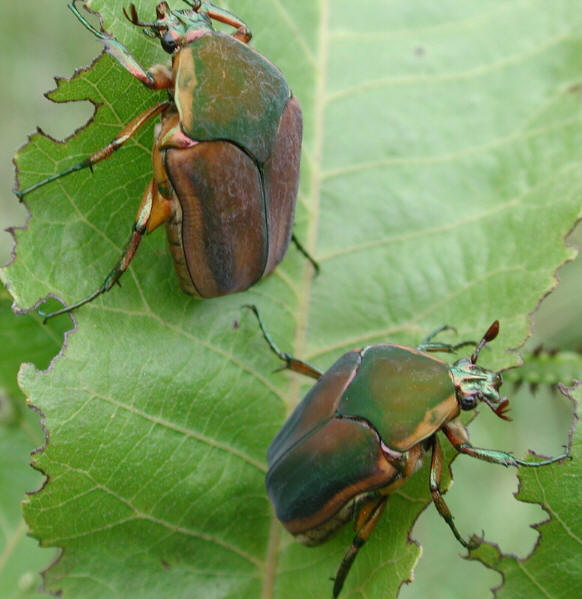June Beetle / June Bug – Phyllophaga species
Family Scarabaeidae – Scarab Beetles
This “June Bug” is a member of the scarab beetle family. Scarabs are stout beetles with large heads and pronotums. Many scarabs have beautiful metallic colors. The scarab beetles’ antennae are distinctive, clubbed and tipped with leaflike plates called lamellae, that can be drawn into a compact ball, or fanned out when sensing odors. The front tibia are evolved for digging. The C-shaped larvae, called grubs, are always pale yellow or white. Both adults and larvae are nocturnal. Many scarabs are scavengers that recycle dung, carrion, and decaying vegetable matter. Others are agricultural pests (i.e. the Japanese beetle). The scarab family has 1300 North American species.
Phyllophaga is a very large genus (more than 260 species) of New World scarab beetles in the subfamily Melolonthinae. Common names for this genus and many other related genera in the subfamily Melolonthinae are May beetles, June bugs, and June beetles. They are medium to large in size (8-25 mm) and are blackish or reddish-brown in color, without prominent markings, and often rather hairy ventrally.
 In the southeastern United States, Cotinus nitida is also colloquially known as “June bug.”
In the southeastern United States, Cotinus nitida is also colloquially known as “June bug.”
Photo: Stephen Friedt
Adult chafers eat the leaves and flowers of many deciduous trees, shrubs and other plants. However, their fat, white grubs (reaching 40-45 mm long when full grown) live in the soil and feed on plant roots, especially those of grasses and cereals, and are occasional pests in pastures, nurseries, gardens, and golf courses. The injury consists of poorly growing patches that quickly turn brown in dry weather. The grubs can be found immediately below the surface, in a characteristic comma-like position.
The grubs sometimes attack vegetables and other garden plants, e.g. lettuce, raspberry, strawberry and young ornamental trees. Injury to the roots and rootstock causes small saplings and tender tap-rooted plants like lettuce to wilt suddenly or to show stunted growth and a tendency to shed leaves prematurely. Plants growing in rows are usually attacked in succession as the grubs move along from one plant to the next. Chafer grubs feed below ground for 3-4 years before changing into adult beetles.
Order Coleoptera: Beetles are the dominant form of life on earth: one of every five living species is a beetle. Coleoptera is the largest order in the animal kingdom, containing a third of all insect species. There are about 400,000 known species worldwide, ~30,000 of which live in North America. Beetles live in nearly every habitat, and for every kind of food, there’s probably a beetle species that eats it.
Beetles Main | Beetles Index | Longhorns | Leaf Beetles | Soldier | Blister | Lady | Scarab
Tree Encyclopedia / North American Insects & Spiders is dedicated to providing family-friendly educational
resources for our friends around the world through large images and macro photographs of flora and fauna.

